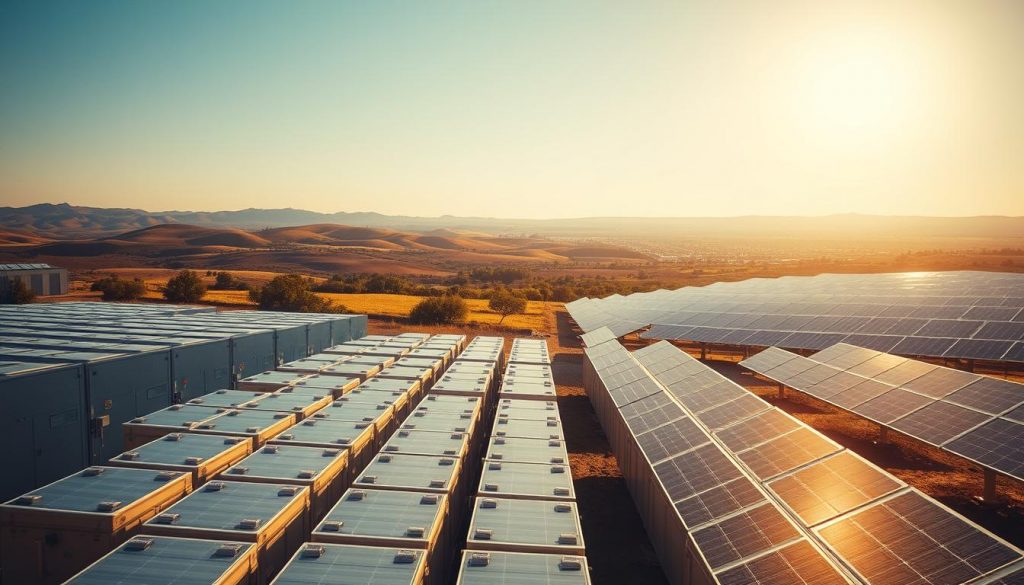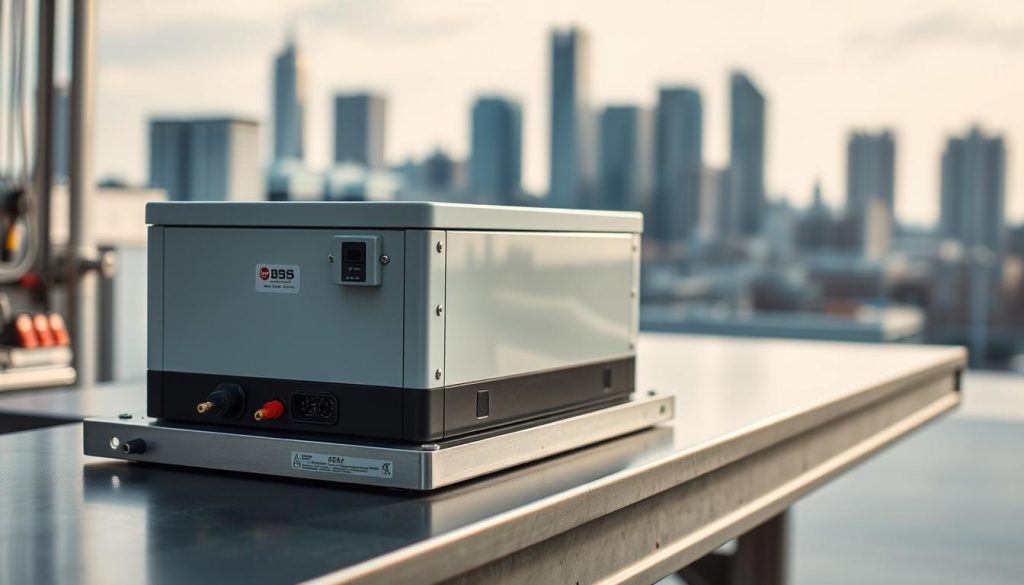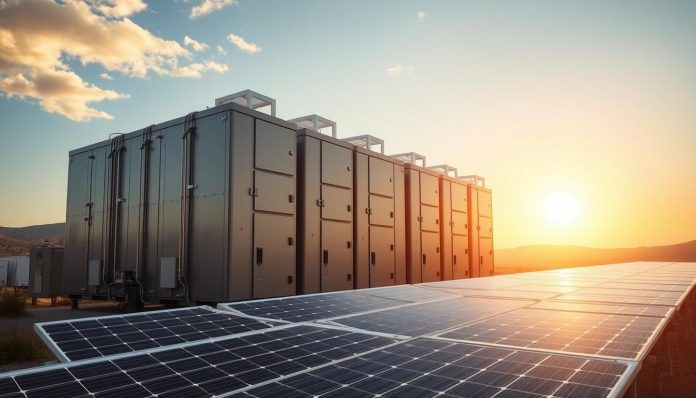Will battery systems and hybrid designs truly sideline diesel back-up in UK sites? This introduction sets the scene for a practical, evidence-based comparison of backup options. It explains why organisations and planners assess alternatives as regulation tightens and sustainability targets become more stringent.
Battery energy storage and hybrid systems are now credible options, showcasing significant advancements in uk technology innovation. Advances in rectifiers, inverters, and new chemistries make rapid, reliable power delivery possible. These systems promise lower noise, no on-site fuel handling, and lifetimes beyond 20 years — clear benefits for many projects.
By contrast, diesel remains a default for resilience, but diesel generators face strict emissions and testing demands. Sectors such as data centres and construction are trialling storage and renewable energy as alternatives. This article outlines the trade-offs in cost, operation, and compliance, and frames where storage, battery energy, and zero-emission generator concepts fit in the transition for the UK industry.
Key Takeaways
- Battery energy storage now offers fast, low-maintenance backup with low noise and long life.
- Diesel still provides proven resilience, but faces rising emissions and compliance pressure.
- Hybrid systems blend storage and generators to reduce fuel use and local pollution.
- Data centres and construction are leading examples of practical deployment today.
- Decision‑making must balance cost, operations and UK policy on sustainability.
Generator fuel sources compared today in the UK: the baseline and the opportunity
Across UK sites, diesel remains the default for on-site power, but viable alternatives, including biofuel generators, are expanding fast.
Diesel sets the baseline for many temporary and standby applications. Petrol and small petrol generators serve light loads, while natural gas generators and propane generators offer near drop-in performance for larger sets.
Biofuels such as HVO and blended fuels reduce tailpipe emissions and often run in existing engines with limited modification. Hydrogen fuel cells present zero-emission generation, though supply chains and refuelling infrastructure remain early-stage in the UK.
Energy storage and battery systems act as complementary systems. They smooth generation, provide ride-through for short outages, and cut run-hours for combustion generator fleets.
The Construction Leadership Council aims to phase out diesel generator use across major firms, pushing sites toward hybrids and solar-ready designs. For national context on renewables and supply trends, see renewable energy in the UK.
| Fuel / System | Availability in UK | On-site needs | Emissions / Notes |
|---|---|---|---|
| Diesel | Widespread | Bulk storage, refuelling | High tailpipe, proven supply chain |
| Natural gas / Propane | Good for fixed sites | Gas lines or cylinders, safety systems | Lower local NOx, near drop-in |
| Biofuels (HVO) | Growing supply | Minor engine adjustments | Lower lifecycle carbon |
| Hydrogen fuel cells | Limited | Special storage, refuelling | Zero tailpipe, infrastructure-limited |
| Battery storage / Hybrid | Increasing | Site footprint, controls, charging | Zero operational emissions, duration limits |
Diesel vs cleaner alternatives: performance, emissions, and practicality side by side
Site planners now weigh combustion units against fuel-cell and battery hybrids for resilience and emissions goals.
Diesel generators retain high starting torque and steady transient handling, making them reliable for heavy loads and long run-hours. Petrol and natural gas sets match some reliability traits but differ in fuel availability and regulated emissions, which affects on-site operation and permitting in the UK.
Propane and biofuel options
Propane offers a near drop-in swap where cylinders or lines are viable. HVO renewable diesel can cut greenhouse gases by up to 91% versus fossil diesel, provided engine approvals are checked and the supply is steady. Fuel costs may be higher, though emissions benefits are clear.
Hydrogen fuel cell generators
Hydrogen units emit only water at the point of use, so they are true zero-emission generators. Current constraints include higher fuel costs, limited production and distribution, and specific storage and safety rules on site.
Battery energy storage systems (BESS) and hybrids
BESS gives fast response, excellent power quality, and lower routine maintenance than combustion sets. Their duration limits suit short outages and peak shaving. Hybrid solar‑BESS with a downsized diesel or gas backup extends autonomy for major events and lowers lifetime costs—field examples from Prolectric and Nixon Hire show strong fuel and cost savings after a few years.
| Option | Performance | Emissions | Practical notes |
|---|---|---|---|
| Diesel | High torque, long run-hours | High tailpipe | Proven supply chain; higher maintenance |
| HVO / Biofuel | Similar to diesel | Up to 91% lifecycle reduction | Check engine approvals; cost premium |
| Hydrogen fuel cell | Smooth, quiet output | Zero at the point of use | Infrastructure and cost are limited |
| Battery / Hybrid | Fast response, peak shave | Zero operational | Duration limits, lower maintenance, and strong ROI examples |
Battery energy storage and hybrid solar systems replacing diesel backup in practice
Practical rollouts show how storage and hybrid controls reduce reliance on combustion plant during most outages.
Data centres are leading pilots that scale battery energy storage to cut the routine run‑hours of the back‑up plant. Global holdings of roughly 20 GW of diesel backup highlight the potential impact of large BESS installations. Modern designs focus on fast response and smooth integration with existing UPS equipment.

Data centre deployments and long-duration pilots
Most battery energy systems historically deliver up to four hours of cover, while many grid interruptions last under two hours. Hybrid controls can start a generator to recharge the BESS and extend coverage to 8+ hours during major events.
Construction sites and mobile hybrid units
Containerised solar‑BESS modules deploy in under four hours. Modules range from 32.7 kWp solar with 67 kWh battery to systems delivering up to 1,720 kWh at 500 kW, plus small standby diesel generators from 40–125 kVA.
| Use case | Typical autonomy | Key benefit |
|---|---|---|
| Data centre | 2–8+ hours | Fast response, UPS integration |
| Long‑duration BESS | 8 hours+ | Reduced generator runtime; large-scale resilience |
| Construction | Hours to days (hybrid) | Rapid deploy, lower maintenance |
Maintenance and controls favour batteries: lower routine servicing than combustion engines, stable electricity quality and near-instant power transfers. Next‑generation chemistries, such as liquid metal batteries, and projects by major firms signal momentum for future storage systems.
Can Clean Energy Replace Diesel Generators? What You Need To Know
Decisions on backup often hinge on how long power is needed and the practical limits of a site.
Use-case fit by hours of autonomy: typical outages vs major events
Battery systems commonly deliver up to four hours of coverage without hybrid support. Most outages last under two hours, so many sites can rely on battery-only backup for routine incidents.
For longer events, hybrid set-ups restart a generator to recharge batteries and can extend autonomy to eight hours or more. Load prioritisation and shedding further stretch available hours during rare, severe incidents.

Operational realities: fuel logistics, testing, servicing, and noise on site
On-site logistics often tip the balance. Regular fuel deliveries and secure storage are costly and subject to disruption. Testing obligations mean engines run even when idle, increasing fuel use and emissions.
Generator noise and exhaust can affect neighbours and site operation. Hybrid and battery-first approaches cut run-time, lowering noise and local pollution while keeping a downsized generator for exceptional events.
Maintenance shifts too: battery systems have fewer moving parts and require less frequent servicing, while retained engines still need scheduled tests and oil changes.
“Many teams find a staged approach works best: start with battery-backed short-duration loads, then add hybrid layers for mission-critical, long-duration needs.”
| Scenario | Typical hours | Key operational notes |
|---|---|---|
| Battery-only | Up to 4 hours | Low noise, minimal fuel, rapid deployment |
| Hybrid (battery + generator) | 8+ hours | Recharge option, load-shedding extends runtime |
| Generator retained | Indefinite (with fuel) | Higher maintenance, testing, and fuel logistics |
Right‑sizing matters: match inverter capacity and start-up current to the load, and plan space, cable routes, and safety zones. Clear operating policies and alarm thresholds help teams manage fuel, track performance, and sequence transitions effectively.
Costs, carbon, and compliance: what changes when diesel is replaced
Replacing routine fuel use with storage and hybrid control reshapes both spending and carbon accounting.
Capex vs Opex
Battery and hybrid systems shift spending from fuel to assets. Higher upfront costs often balance lower operating costs from fewer fuel deliveries and less routine servicing.
Field data shows quick payback in constrained sites. Prolectric reports parity after 2 years 4 months, then >£50k saved by year 5. Nixon Hire cited £56,000 saved and 79 tonnes of CO2 avoided in one fleet review.
Carbon reductions today
Hybrid operation cuts run-hours and carbon emissions compared with continuous fossil use. HVO gives an immediate carbon benefit where engine approvals allow.
Major firms such as Microsoft and Google are moving away from on-site fuel and using large battery storage to shrink their scope emissions.
UK policy and compliance
Site teams must report carbon and electricity data. Telemetry from energy storage systems supports audit-ready records and helps meet industry targets and public sustainability news.
| Category | Short-term | Long-term (years) |
|---|---|---|
| Capex | Higher for batteries | Amortised over asset life |
| Operating costs | Lower fuel and servicing costs | Reduced callouts, spares and oil changes |
| Carbon | Reduced via hybrids or HVO | Near-zero with fuel-cell or large BESS |
| Compliance | Telemetry and reporting needed | Aligns with industry targets and procurement rules |
Procurement tip: specify generation, storage, and control requirements in tenders. This enables apples-to-apples comparisons and clearer lifecycle value for operators.
decarbonising data centres and the energy outlook for 2025 offer further context on policy and industry trends.
Technology news UK and industry insights: innovation shaping a clean energy future
Recent UK trials show solar-plus-storage is moving from pilot to mainstream on construction and data centre sites.
Policy momentum is clear. The Construction Leadership Council urged the top 500 firms to phase out diesel generator use by 2025 and cut diesel consumption by 78% by 2035. This drives procurement for hybrid solar and sustainable technology storage that works in UK winter conditions.
UK construction’s diesel phase-down momentum and solar maturity
Major contractors now specify solar-ready kits and compact storage on short-term sites. The market sees this as a practical route to lower noise and reduced on-site carbon emissions.
Storage breakthroughs: long-duration BESS and liquid metal batteries on the horizon
Large projects overseas, such as a planned 69 MW / 552 MWh 8-hour battery energy storage installation, show that scale is feasible. These projects, highlighted in various technology articles, point to longer autonomy and lower lifecycle carbon for standby power.
Liquid metal batteries from firms like Ambri promise long cycle life, non-flammable operation and roughly 80% round-trip efficiency. Trials with major cloud operators suggest a route for battery energy storage to substitute routine generator running over coming years.
- Major cloud operators (Microsoft, Google, Meta) are scaling BESS in data centres, changing supplier demand.
- Hybrid architectures that combine solar, batteries, and a compact gas or diesel generator offer a pragmatic bridge today.
- Improved telemetry and controls extend battery life, optimise dispatch, and verify carbon savings for regulators.
| Trend | Industry impact | Example |
|---|---|---|
| Long-duration storage | Extends backup hours | 69 MW / 552 MWh 8-hour project |
| New chemistries | Lower risk, longer life | Liquid metal battery tests with data centres |
| Digital controls | Better dispatch & reporting | Telemetry for carbon accounting |
“As storage improves, dependence on a diesel generator for every site diminishes, changing procurement norms and noise and emissions profiles.”
What to watch in UK technology news: hydrogen infrastructure rollout, standardisation for storage system safety, and best-practice guidance for construction and data centre sites. These items will shape the total cost of ownership and the practical mix of generation and storage on site.
Conclusion: Can Clean Energy Replace Diesel Generators? What You Need To Know
In short, operational trials and UK deployments show hybrid solar‑BESS and battery energy systems cut fuel spend and lower carbon on many sites, providing valuable technology industry insights, including the potential of zero-emission generators.
Traditional diesel retains a role for prolonged, rare events, but evidence shows batteries and storage now substitute a large share of routine generator hours. Data centre pilots illustrate this shift away from traditional diesel for backup, moving towards zero-emission generators.
Practical next steps: audit loads, model hours of autonomy, and specify hybrid systems that prioritise low‑carbon power while keeping a small generator for resilience. This pathway reduces costs, simplifies maintenance, and improves air quality as fossil-run hours fall, paving the way for zero-emission generators.
Teams should capture site telemetry, verify savings, and scale solutions over time. In short, the alternative mix of storage, solar and selective backup offers a clear route to a more sustainable power future.
For more articles on Energy, please follow the link.


